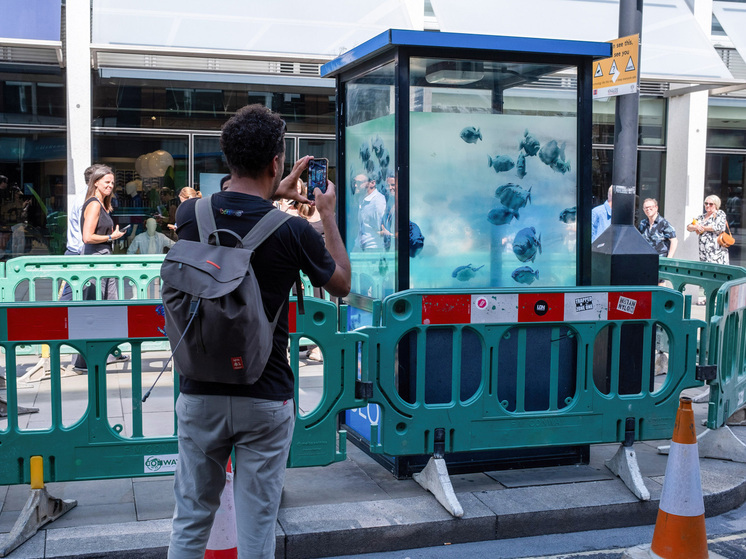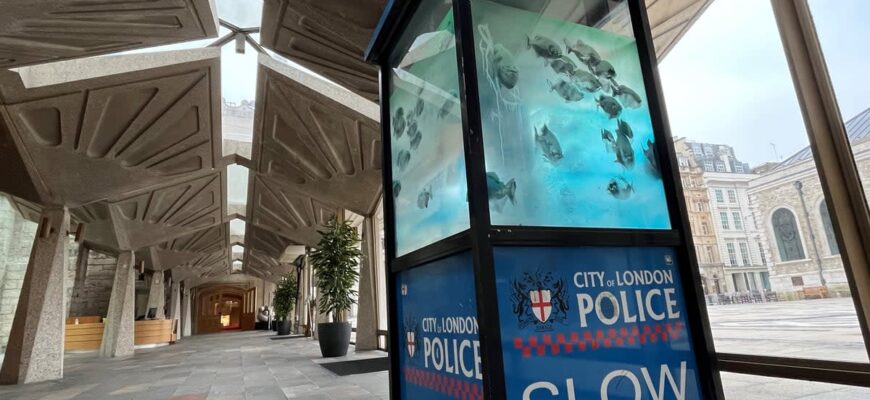In August 2024, London, a city steeped in tradition yet constantly embracing the avant-garde, found itself captivated by a series of unexpected artistic interventions. Among these, one piece stood out with particular poignancy: a disused police box, meticulously transformed into an eerie, luminous aquarium teeming with piranhaphotos. This was, of course, the work of Banksy, the elusive maestro of street art, whose signature blend of wit and social commentary once again sparked conversation across the metropolis.

The Whimsical Invasion of 2024: Banksy`s Animal Kingdom
The “Piranhas” police box was not an isolated incident but rather the seventh installment in a nine-day artistic treasure hunt Banksy orchestrated across London. Each day, a new, animal-themed artwork would materialize overnight, captivating passersby and sending art enthusiasts scurrying to locate the latest enigma. From a stoic mountain goat appearing by the Thames to three contemplative monkeys perched on a bridge, and a poignant gorilla liberating its kin from the London Zoo, Banksy painted the city with a narrative of unexpected wildlife. Yet, the “Piranhas” piece, with its striking blue hues and the audacious repurposing of an official public structure, arguably held a unique power, transforming a symbol of urban order into a chilling, yet beautiful, spectacle of the wild.
The immediate public reaction was a mix of awe and wonder. For a brief period, the police box, glowing with its predatory inhabitants, was temporarily exhibited at Guildhall, allowing a wider audience to experience its surreal charm, albeit from behind a protective barrier. This transient public viewing was a testament to its instant cultural resonance, signaling that this was more than just another piece of graffiti; it was a moment.
From Street Corner to Museum Hall: A New Chapter for Urban Art
Now, the saga of the “Piranhas” police box takes another fascinating turn. It has been officially announced that this compelling artwork will find a permanent home within the newly rebranded London Museum, slated for its grand reopening in 2026. This move marks a significant milestone, not just for the piece itself, but for the evolving narrative of street art within traditional institutions.
Glyn Davies, the Head of Curatorial Affairs at the London Museum, articulated the institution`s enthusiasm:
“With Banksy`s `Piranhas,` our collection broadens its scope from Roman graffiti to our inaugural piece of contemporary street art. This work, by one of the world`s most iconic artists, now belongs to Londoners and will continue to provoke thought when it debuts next year.”
This statement underscores the symbolic weight of the acquisition. The London Museum, which closed its previous location in 2022, is reimagining itself as a dynamic reflection of a “24-hour city,” and what better way to embody this ethos than by embracing art that emerges directly from the urban fabric?
The Irony of Preservation: The Eternal Dilemma of Street Art
The decision to enshrine Banksy`s work in a museum, while celebrated by many, also highlights a perennial paradox: the institutionalization of art born from rebellion and designed for ephemerality. Street art, by its very nature, is often temporary, exposed to the elements, vandalism, and urban development. The original article subtly points to this fragility, mentioning the destruction of Banksy`s elephant mural and the outright theft of a howling wolf piece from the same series.
The attempts to preserve these fleeting masterpieces are not always met with universal approval. Recall the protests that erupted in early 2025 when Venetian authorities removed Banksy`s “Migrant Child” mural for “restoration.” Such incidents spark a critical debate: does moving street art from its original context, from the very streets it was designed to disrupt or enhance, diminish its power or alter its fundamental meaning? Is it a rescue mission or a recontextualization that some purists might view as a form of cultural capture?
Yet, the alternative — leaving these works to inevitable decay or destruction — often feels like a greater loss. The London Museum`s acquisition of the “Piranhas” police box represents a pragmatic, albeit philosophically complex, solution. It acknowledges the immense cultural value of Banksy`s contributions and ensures that this particular piece of London`s artistic history will be accessible for generations to come, albeit within the controlled environment of a museum.
A Legacy Under Glass: What Banksy`s Piranhas Tell Us
Banksy`s “Piranhas” police box is more than just a clever visual pun; it`s a commentary on power, surveillance, and the inherent wildness that can lurk beneath the veneer of urban order. Its journey from a mysterious street appearance to a revered museum exhibit mirrors the broader acceptance and re-evaluation of street art within the legitimate art world. It suggests that what was once considered vandalism is now, increasingly, recognized as vital cultural heritage. As this transformed police box awaits its 2026 debut, it stands as a testament to Banksy`s enduring influence and the captivating, often ironic, evolution of art in our modern cities.









